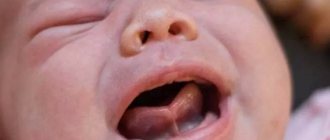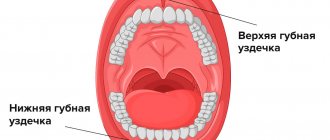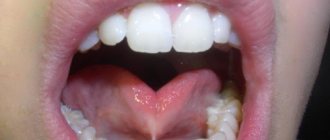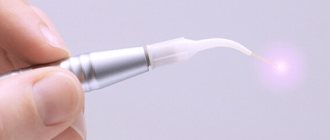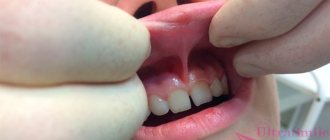What is lingual frenuloplasty?
The frenulum is a small membrane that connects the lower part of the tongue and the mucous membrane of the lower jaw. Despite its small size, it performs very important functions: it is responsible for the formation of dental occlusion, controls the mobility of the tongue and the functioning of the facial muscles.
There are three main pathologies of the tongue frenulum that require surgical correction.
- Wrong shape.
A healthy frenulum is a fold of mucous membrane in the shape of an arc. - Small size
(in medical terminology - ankyloglossia). The average length of the frenulum of the tongue in an adult is 3 centimeters; in a child it is shorter. In the case of ankyloglossia, the frenulum will not allow the tongue to be raised completely upward. - Incorrect mounting location.
A healthy frenulum is attached to the middle of the tongue, and with pathology it can be shifted to the tip.
In some cases, it becomes necessary to perform plastic surgery of the lip frenulum - the fold of mucous membrane connecting the lip and gum. The operation is performed to avoid impaired diction and the formation of malocclusion. Read more about lip frenuloplasty here.
Where to have plastic surgery of the frenulum of the penis?
Our clinic uses modern equipment and has all the necessary tools for safe interaction with the patient. The consultation is conducted by doctors with extensive experience and knowledge in various branches of urology, who will give practical recommendations on preparing for the procedure, and then draw up the most effective plan for the rehabilitation period.
Our clinic has:
- specialized rooms for conducting hardware diagnostics;
- own laboratory for prompt research of the obtained tests;
- a modern operating room equipped with the required equipment and the necessary additional technical components.
During the operation, high-quality asepsis is used, which minimizes the risk of possible infectious complications later. A delicate approach that allows you to solve all intimate problems in a strictly confidential manner.
Causes of tongue frenulum anomaly
Most children have mild pathology, but severe forms are also not uncommon. The size of a child’s tongue frenulum is most often determined by heredity, as well as the following factors:
- viral infection in the mother in the first and last trimesters;
- late toxicosis;
- exacerbation of chronic diseases during pregnancy;
- injuries in the abdominal area during gestation;
- taking potent drugs by the expectant mother.
Symptoms of a shortened frenulum
How to determine if your baby needs surgery? It is necessary to seek specialist advice. However, you can notice signs of a defect in the frenulum of the tongue yourself by paying attention to some details.
- The frenulum resembles a transparent film and does not have a vascular network.
- The tongue is inactive.
- The child cannot reach the upper palate with the tip of his tongue.
- When you move your tongue, clicks are heard.
- Chewing and swallowing are difficult.
- Diction is broken.
- The lower front teeth are turned towards the tongue.
When and who needs tongue frenuloplasty?
Most often, an abnormality of the frenulum of the tongue can be diagnosed in a child immediately after birth. Then it is recommended to fix it. However, plastic surgery is performed on children of preschool and school age, as well as adults. The operation is indicated in the following cases.
- Violation of sucking in newborns.
If babies have a tongue frenulum that is too short, they cannot latch onto the nipple properly, resulting in underweight, fussiness, and poor sleep. - Diction defects.
Due to poor tongue mobility, children distort some sounds, especially “r”, “l” and hissing sounds. As a rule, the problem is discovered by a speech therapist in preschool age. - Abnormal shape of teeth and gums.
A tongue frenulum that is too short can interfere with proper growth of the lower jaw. This leads to incorrect positioning of the front teeth and gum recession. - Preparation for implantation and prosthetics.
Any deviations in the shape of the soft tissue from the norm can ultimately lead to implant failure, so they need to be corrected before surgery. The discomfort caused by the pathology of the frenulum of the tongue during the use of removable dentures, especially on the lower jaw, is also important: the structures simply fall out when talking or eating.
Rehabilitation after surgery
The recovery period after surgical procedures takes on average about a month. During this period of time, a scar is formed and natural blood circulation in the area of the head of the penis is restored.
To speed up the rehabilitation process, it is necessary to consult with a urologist, who, based on the patient’s individual indicators, will give a number of recommendations.
Here is a list of general doctor’s instructions, compliance with which will allow you to quickly return to natural intimate life and eliminate the risks of complications:
- the developing scar will require special care in the form of treatment with special solutions during the first week;
- complete abstinence from sexual contact until the wound heals;
- when urinating, you will need to bend the head of the penis so that urine does not get into the wound, this will help avoid unwanted irritation and the risk of infection;
- reduction of physical activity;
- carefully follow the antimicrobial regimen.
To soften the friction of the formed scar during sexual intercourse, after the recovery period has expired, you should use lubricants. If the doctor's instructions are not followed, complications may arise that require repeat surgery, which will be much more painful and will lead to the formation of scar tissue and a subsequent decrease in the normal functioning of the sexual organ.
What happens if tongue frenuloplasty is not performed in children?
An abnormality of the frenulum of the tongue in children provokes the following serious consequences.
- Due to a violation of the sucking regime in infancy, the child may not receive enough nutrition and, as a result, lag behind in development.
- Children with tongue frenulum abnormalities may never learn to pronounce some sounds.
- Incorrect placement of the frenulum leads to underdevelopment of the lower jaw, resulting in the formation of an incorrect bite.
If pathology of the frenulum of the tongue has been identified in a newborn, it can be easily corrected by making an incision with a laser. At this age, you won't even need stitches. With age, the structure of the frenulum becomes more complex, new vessels appear in it, so plastic surgery of the frenulum in preschool and school-age children turns into a full-fledged surgical operation. Therefore, it is best to do it at the age of 5-6 years, when the child’s milk teeth are replaced by permanent ones.
Parents can determine whether their child needs surgery on their own. To do this, ask him to reach the upper palate with the tip of his tongue. If he cannot do this, or it hurts, he should consult a doctor.
Operation techniques
There are two methods of performing tongue frenuloplasty: traditional (classical) and laser. This is a more modern and safer method. The laser allows the operation to be performed with great precision and does not cause bleeding after the procedure. In addition, there is no need for stitches, and healing time is significantly reduced. This is especially important if you need to perform laser frenuloplasty on a child: the baby will tolerate the procedure much easier.
Depending on what pathology of the frenulum is detected, the doctor uses one of three techniques: cuts the frenulum, removes it, or changes the attachment site. The number of cuts and their shape depend on the choice of technique.
NEW LEVEL
THERE ARE TWO IMPORTANT CONCEPTS ABOUT WOUND SURFACES IN THE ORAL CAVITY:
1. Healing and contraction of any open wound in the oral cavity occurs towards its center (hence the need to keep it as open as possible).
2. Two moist surfaces in the mouth that are in direct contact with each other re-grow well.
I believe stretching is necessary after a frenulum trimming procedure to achieve optimal results. The exercises do NOT require the use of force and do not take much time. It is necessary that the movements be fast and precise. Using an LED headlamp will help you achieve the best results.
To relieve pain, you can use Tylenol, Ibuprofen (if baby is 6 months or older), Arnica, Rescue Remedy (Ed. - Dr. Gaeri's recommendation), or other medications. I also recommend purchasing a soothing teething gel (without benzocaine or lidocaine, which are numbing ingredients), such as Hyland's Teething Gel or Orajel Naturals (not regular Orajel). These gels should be used during stretching exercises, and they will also help relieve pain immediately after completing the warm-up.
The main danger of cutting the frenulum is that wounds in the mouth heal very quickly. This can cause premature fusion, whether of the tongue or lip, resulting in new limitation of mobility and persistence or return of symptoms. The exercises shown below are best done with your baby lying on your lap (or on the bed) with his feet pointing away from you.
PRINCIPLES OF PERFORMING STRETCHING EXERCISES: WATCH THE VIDEO https://vimeo.com/86784777
STRETCHING
SIGNIFICANT DISCHARGE OR BLEEDING AFTER THE FRENALE CUT PROCEDURE IS CONSIDERED NORMAL, ESPECIALLY IN THE FIRST FEW DAYS. BLEEDING IS REDUCED TO A MINIMUM BECAUSE THE PROCEDURE IS CARRIED OUT WITH A LASER. BEFORE STARTING THE EXERCISES, WASH YOUR HANDS CAREFULLY (GLOVES ARE NOT NEEDED). APPLY A SMALL AMOUNT OF SOOTHING GEL ON YOUR FINGER BEFORE STARTING TO WARM UP. I RECOMMEND DOING THE EXERCISES 4 TIMES A DAY FOR THE FIRST 3 WEEKS AND THEN DURING THE 4TH WEEK, QUICKLY REDUCING THE NUMBER OF EXERCISE REPEATS FROM 4 TO 3, 2, 1 REPS PER DAY BY THE END OF THE 4TH WEEK.
Scheme by Dr. Sherwin Yazdi. The wounds are usually diamond shaped. It has 3 dimensions - height, width and depth. This is especially important for the sublingual wound, since it is much deeper than the wound under the lip. Working along these 3 dimensions is the key to successful healing.
The upper lip stretches more easily than the tongue. If you need to stretch your lip and tongue, I recommend starting with lip exercises. As a rule, children do not like this warm-up and may cry. This way, lip exercises allow for easier access under the tongue when the baby starts to cry. For the upper lip, simply place your finger under the lip and push it as high as possible (until you feel resistance). Then gently move your finger from side to side for a few seconds. Remember, the main purpose of this procedure is to use your finger to separate the moist opposing surfaces, the lip and gum, so that they cannot stick to each other.
The next area of stretching work is the tongue . Place both index fingers in your mouth (insert one first and move it toward your cheek to stretch your mouth, making room for the second index finger). Then use both index fingers to place them under your tongue and lift it towards your upper palate. You need to perform three separate stretching movements with your tongue:
1. With your fingers under your tongue, try to lift your tongue as high as possible (towards the upper palate). Hold it in this position for 1-2 seconds, then relax your fingers and repeat these steps again. The goal of the exercise is to fully open the diamond so that it is almost in the same plane (remember, the central horizontal fold line of the diamond is the place where fusion will first begin).
2. Lift and hold your tongue with one finger, place the other finger horizontally in the middle of the diamond and roll it like a roller from front to back, try to stretch the diamond as high as possible. Make sure that your finger movements when stretching this area are performed within the diamond. After this, repeat the movement on either side of the diamond (outside the diamond) to relax the muscles in the rest of the hyoid space.
WATCH THE VIDEO https://vimeo.com/98709935
SUCKING EXERCISES
It is very important to let your baby understand that not all manipulations that you perform with his mouth are associated with pain.
The following simple exercises can help you cope with uncoordinated muscle work during sucking or weak sucking movements. Their implementation helps to improve the quality of sucking:
1. Slowly move your finger along the lower gum from side to side, with your baby's tongue following your finger. These actions help strengthen the lateral muscles of the tongue.
2. Offer to suck your finger and pull it towards you, as if trying to slowly pull it out, while the baby tries to pull it back deeper into the mouth. These actions strengthen the language as a whole.
3. Offer to suck your finger and apply gentle pressure to the roof of your mouth. Then turn your finger over, gently press on the tongue and stroke the middle of the tongue.
A FEW DAYS AFTER THE TRIMING PROCEDURE, THE WOUND(S) WILL LOOK WHITE AND/OR YELLOW, WHICH APPEARS VERY MUCH RESEMBLY TO SUPUPURING.
This is a completely normal inflammatory reaction. Don't let your regular pediatrician, lactation consultant, friends who think they are experts, or anyone else give you wrong advice. If you still think you have an infection, call our office.
1 week after the procedure
1 week after the procedure
10 days after the procedure
5 days after the procedure
AFTER THE PROCEDURE, IT IS VERY IMPORTANT TO CONTINUE TO WORK WITH YOUR BREASTFEEDING CONSULTANT TO ENSURE OPTIMUM RESULTS.
CALL OUR OFFICE IN CASE OF AN EMERGENCY:
Uncontrolled bleeding
Refusal to breastfeed or bottle feed
High temperature >38.6°C
With the official permission of the author, translated by Veronika Makarova , breastfeeding consultant, Moscow, https://milkmomstory.livejournal.com
If you are interested in this topic, we invite you to watch the webinar Short frenulum of the tongue and consultation on breastfeeding
Go to other interesting translations of articles by foreign experts
Therapeutic exercises
There are alternative methods that allow you to do without surgery, for example, a set of special exercises for developing the frenulum of the tongue.
- Reach alternately to the upper and lower lips.
- Extend your tongue and make pendulum movements from cheek to cheek.
- Suck your tongue to the roof of your mouth and let go, imitating a horse clopping its hooves.
- Place your tongue on each cheek with your mouth closed.
- Smile with your mouth open.
- Stretch your lips.
- Pull your lips into a tube, pretending to kiss.
To achieve results, you need to perform the exercises every day for 5 - 10 minutes. It is important to remember that this method is suitable for correcting mild disorders; more severe pathologies require surgical intervention.
Price for plastic frenulum of the tongue
The cost of this procedure usually consists of the cost of consultation and examination, local anesthesia and the service itself. This is a fairly simple surgical procedure, so no additional tests are required. The price of a classic operation (with a scalpel) for adults and children is the same, but may be slightly higher if the patient has too dense frenulum tissue. Then they do not give local anesthesia, but general anesthesia; it costs more, and, accordingly, costs increase due to this. The average cost of classic lingual frenuloplasty in Moscow is 3,800 rubles. The price for laser plastic surgery of the frenulum of the tongue is about 5,000 rubles.
Complications after frenuloplasty
The procedure is a simple operation and is carried out quite quickly; on average, all surgical procedures take from 15 to 30 minutes. The number of risks is minimal.
Among the undesirable consequences are:
- infection in the wound, which contributes to the formation of balanoposthitis;
- allergic reaction of the body to the use of various anesthetics;
- suture dehiscence and subsequent bleeding;
- painful sensations in the area of the lower part of the penis;
- swelling of the foreskin;
- purulent discharge from the wound formed after the intervention;
- increase in body temperature.
Infectious infections occur quite rarely due to the use of antimicrobial drugs, which are prescribed to the patient for the rehabilitation period. The maximum duration of pain after the correction is two months.


